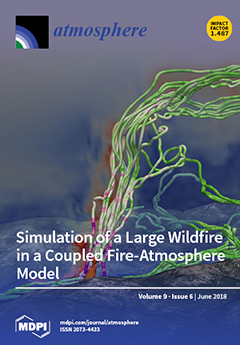Past studies suggest that certain properties of fire emitted particulate matter (PM) relate to the combustion phase (flaming, smoldering) of biomass burning, but to date there has been little consideration of such properties for use as combustion phase indicators. We studied the thermochemical
[...] Read more.
Past studies suggest that certain properties of fire emitted particulate matter (PM) relate to the combustion phase (flaming, smoldering) of biomass burning, but to date there has been little consideration of such properties for use as combustion phase indicators. We studied the thermochemical properties of PM
2.5 emitted from experimental and prescribed fires using multi-element scanning thermal analysis (MESTA). Resulting thermograms show that the carbon from PM
2.5 generally can be grouped into three temperature categories: low (peak ~180 °C), medium (peak between 180–420 °C), and high (peak > 420 °C) temperature carbons. PM
2.5 from smoldering phase combustion is composed of much more low-temperature carbon (fraction of total carbon = 0.342 ± 0.067,
n = 9) than PM
2.5 from the flaming phase (fraction of total carbon = 0.065 ± 0.018,
n = 9). The fraction of low-temperature carbon of the PM
2.5 correlates well with modified combustion efficiency (MCE;
r2 = 0.76). Therefore, this MESTA thermogram method can potentially be used as a combustion phase indicator solely based on the property of PM
2.5. Since the MESTA thermogram of PM
2.5 can be determined independently of MCE, we have a second parameter to describe the combustion condition of a fire, which may refine our understanding of fire behavior and improve the accuracy of emission factor determinations. This PM
2.5 indicator should be useful for discerning differential diffusion between PM
2.5 and gases and providing insight into the impact of PM emission on atmospheric environment and the public health.
Full article





